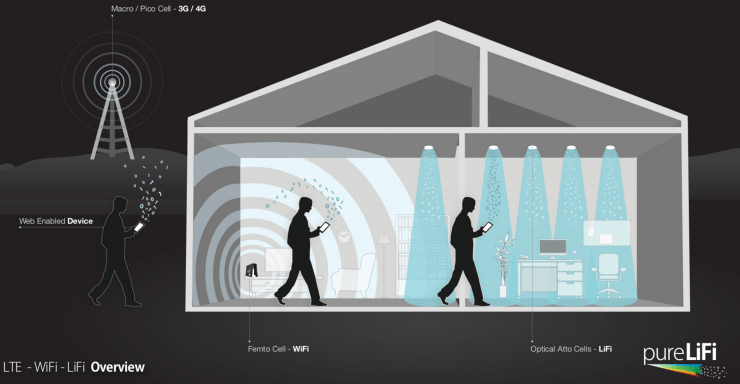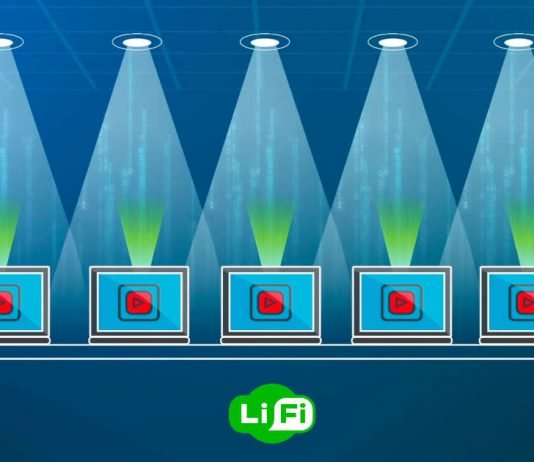The demand for faster and more reliable wireless communication technologies is ever-growing. One such technology that has been making waves in recent years is LiFi or Light Fidelity. This article will delve into the intricacies of LiFi technology, its comparison with Wi-Fi, and its potential impact on our future.
Contents
- 1 What is LiFi?
- 2 How does LiFi work?
- 3 LiFi vs Wi-Fi
- 4 Advantages of LiFi:
- 5 Limitations of LiFi:
- 6 Potential Applications of LiFi:
- 7 The Future of LiFi
- 8 FAQ About LiFi Technology:
- 8.1 1. Is LiFi just another name for Visible Light Communication (VLC)?
- 8.2 2. Do lights need to be fully on for LiFi to work efficiently?
- 8.3 3. Do the lights flicker a lot when using LiFi, causing headaches?
- 8.4 4. Is LiFi unidirectional?
- 8.5 5. Can LiFi work in sunlight?
- 8.6 6. Does LiFi require ‘Line-Of-Sight’?
- 8.7 7. Does LiFi need special LEDs to work properly?
- 8.8 8. Is LiFi a complex technology and cannot work with Wi-Fi?
What is LiFi?
LiFi, also known as “Light Fidelity,” is a wireless optical networking technology that uses light-emitting diodes (LEDs) to transmit data. This technology was first demonstrated in 2011 by Professor Harald Haas during a TED Global Talk on Visible Light Communication (VLC). Professor Harald Haas is known as the “Father of LiFi”, and he is also the founder of PureLiFi, a pioneering company in the development of LiFi technology.
VLC uses light sources emitting at visible wavelengths between 400 and 800 THz (780–375 nm) to deliver high-speed communication, similar to Wi-Fi, and complies with the IEEE standard IEEE 802.15.7. LiFi is a subset of VLC and, as explained by Professor Harald Haas, uses the visible light spectrum instead of radio waves to transmit data. This approach opens up a vast spectrum — 10,000 times larger than the entire radio frequency spectrum. It’s a game-changer, offering the potential for faster and more secure data transmission.
How does LiFi work?
The process is intriguing yet straightforward. LiFi constitutes several light bulbs that form a wireless network. When an electrical current is applied to a LED light bulb, a stream of light (photons) is emitted from the bulb. The brightness of the light flowing through the LED bulbs can be changed at extremely high speeds, allowing the signal to be sent by modulating the light at different rates. The signal is then received by a detector that interprets the changes in light intensity as data. When the LED is ON, it transmits a digital 1, and when it’s OFF, it transmits a 0. The intensity modulation cannot be seen by the human eye, making the communication as seamless as other radio systems.
LiFi vs Wi-Fi
| LiFi | Wi-Fi |
|---|---|
| Data transmission using light via LED bulbs. | Data transmission using radio waves via Wi-Fi router. |
| LiFi is connected to LED bulbs, and it does not require additional power consumption, thus reducing costs in homes and workplaces. | Wi-Fi requires electronic devices such as routers, modems, signal repeaters, wave amplifiers, and antennas, which consume energy 24/7. |
| Present IrDA (Infrared Data Association) compliant devices. | WLAN (Wireless Local Area Network) 802.a/b/g/n/ac/ad standard compliant devices. |
| No interference issues: Less interference, can pass through salty sea water, works in the dense region. | Interference issues from nearby access points: More interference, cannot pass through seawater, works in less dense regions. |
| Light cannot go through walls and, therefore will provide a more secure data transfer. | RF can go through walls and therefore need to employ techniques for secure data transfer. |
| Can reach transfer speed between 1 Gpbs to 20 Gpbs. | 150 Mpbs with WLAN 11n, 1 Gbps to 2 Gpbs with WiGig/Giga-IR. |
| 10,000 times the frequency spectrum of radio waves. | Frequency of operation: 2.4GHz, 4.9GHz and 5GHz. |
| Work in high dense environments. | Work in less dense environments. |
| The coverage distance is about 10 meters. | Can reach 32 meters. |
LiFi operates in the 800nm to 1,000nm band of the electromagnetic spectrum, offering a minimum throughput of 10 Mb/s and a maximum of 9.6 Gb/s at the MAC data service access point. This speed is comparable to the latest Wi-Fi 6 technology, which also tops out at 9.6 Gb/s.
However, LiFi’s potential extends beyond speed. The technology is being positioned as a complement to Wi-Fi systems, providing a way to add extra bandwidth without increasing network congestion or interference. It also has the potential to replace cables by short-range optical wireless links, connecting numerous sensors and actuators to the internet.

Advantages of LiFi:
- High Speed: One of the key advantages of LiFi technology is its speed. The high-speed nature of LiFi could make it a game-changer in the world of wireless communication. With the ability to transmit data at high speeds, LiFi could significantly improve the functionality of city infrastructure.
- Increased Security: LiFi technology offers increased security, particularly in areas where radio frequencies may be unsafe or unavailable. This is because light cannot penetrate through walls, which makes it a lot harder for potential hackers to gain access to your wireless data.
- Alleviating the Spectrum Crunch: Another advantage of LiFi is its potential to alleviate the spectrum crunch. As the consumption of wireless data increases by 60% every year, the radio-frequency space is slowly becoming saturated. LiFi, with its use of the visible light spectrum, could be the solution to this impending spectrum crunch.
- Environmental Sustainability: LiFi technology is not only fast, but it is also environmentally sustainable. One of the main advantages of LiFi technology is that it eliminates the need for electronic devices such as routers, modems, signal repeaters, wave amplifiers, and antennas, which consume energy 24/7.
- Potential to Use Solar Energy: LiFi technology has the potential to use solar energy to transmit data, making it possible for people without internet access or with limited electricity resources to connect wirelessly to the web.
- Bridging the Digital Divide: With LiFi, there is a great opportunity to bring internet access to remote and underdeveloped regions, which can help bridge the digital divide.
Limitations of LiFi:
- Line of Sight: LiFi technology requires a clear line of sight. This means that any object or obstacle that blocks the path of light will disrupt the data transmission. This is a significant limitation, especially in environments where mobility is essential.
- Range: The range of LiFi is relatively short compared to other wireless technologies like Wi-Fi. LiFi signals cannot penetrate walls or travel long distances, limiting its use to specific areas or rooms.
- Light Dependency: LiFi relies on light to transmit data. This means that it cannot be used in dark environments or areas with inconsistent lighting. It also cannot be used outdoors in direct sunlight as the sunlight can interfere with the signal.
- Hardware Requirements: To use LiFi technology, both the transmitting and receiving devices need to be equipped with specific hardware. This can be a barrier to adoption, especially for existing devices that are not LiFi-compatible.
- Cost: The cost of implementing LiFi technology can be high, especially considering the need for specific hardware and the potential need for significant changes to existing infrastructure.
Despite these limitations, it’s important to note that LiFi technology is still in its early stages of development. As technology evolves, some of these limitations may be overcome. For example, companies like pureLiFi are working towards miniaturizing the technology and making it more affordable, which could help address the cost and hardware limitations.
Potential Applications of LiFi:
- Urban Infrastructure: LiFi technology can significantly improve the functionality of city infrastructure. For instance, street lamps could soon be used to provide data to everything from pedestrians to vehicles. This could lead to smarter, more connected cities.
- Industrial Settings: Currently, LiFi is mainly used in industrial settings where traditional Wi-Fi may not be as effective. The high-speed and secure nature of LiFi makes it ideal for use in these environments.
- Smart Homes and Building Automation: LiFi is predicted to make its way into smart homes and become an integral part of future building automation. This could lead to more efficient and connected homes.
- Defense and Healthcare: Companies across various industries, such as defense and healthcare, are working on LiFi solutions for various use cases. The secure nature of LiFi makes it ideal for use in these sensitive areas.
- IT Infrastructure and Telcos: More and more companies in the IT infrastructure and telecommunications sectors are realizing the potential of LiFi and investing resources in research and product development. This could lead to more efficient and secure communication networks.
- Device Integration: The LiFi-XC system, released in 2017, is a certified plug-and-play system that works with USB devices and can be integrated into laptops, tablets, and smart appliances. This shows the potential for LiFi to be integrated into a wide range of devices in the future.
- Other LiFi applications include underwater communications, aeroplanes, retail, trains, car-to-car communications, GPS, augmented reality, and virtual reality.
The Future of LiFi
The recent approval of the LiFi wireless networking specification, IEEE 802.11bb, by the electrical engineering body (IEEE) marks a significant milestone. This global standard, which supports wireless networking using visible and infrared light, outlines the necessary changes to physical layers (PHY) and the medium access control layer (MAC) to enable 802.11 wireless networking via light source modulation.
The approval of the LiFi spec has been celebrated by companies like pureLiFi and Fraunhofer HHI. They believe that the new standard sets the stage for LiFi systems to interoperate with Wi-Fi networks, enabling the development of novel LiFi applications.
In conclusion, LiFi technology is not just a promising concept; it’s a reality that’s here to stay. As we continue to demand faster, more secure, and more reliable wireless communication, LiFi stands poised to light the way.
FAQ About LiFi Technology:
1. Is LiFi just another name for Visible Light Communication (VLC)?
No, while both LiFi and VLC transmit data using LEDs, they are not the same. VLC is a point-to-point light communication network with controlled features operated at low or moderate data rates. On the other hand, LiFi supports high to ultra-high data rates and is bidirectional, unlike VLC, which is unidirectional.
2. Do lights need to be fully on for LiFi to work efficiently?
No, even if the lights are dimmed, LiFi will still work and transmit your data. The LiFi dongle is sensitive to low lights, and even the minimum level of luminescence can get this technology working.
3. Do the lights flicker a lot when using LiFi, causing headaches?
No, the current supply to the LED devices is modulated at a speed that is not perceptible to the human eyes. The flickering won’t cause headaches as it won’t affect us.
4. Is LiFi unidirectional?
No, LiFi is a full duplex communication technology that uses infrared energy for the uplink and visible light for the downlink.
5. Can LiFi work in sunlight?
Yes, LiFi can work in the presence of sunlight. Interference from natural or artificial sources can be reduced using optical filters, enabling LiFi to work even outdoors.
6. Does LiFi require ‘Line-Of-Sight’?
While the signal would be stronger in the presence of line-of-sight, LiFi can still receive data at a lower data rate if light levels are low. This means that line-of-sight is an advantage but not a necessity.
7. Does LiFi need special LEDs to work properly?
No, the current LED lights and ordinary lamps can perfectly work to provide light communication based on factors defining illumination.
8. Is LiFi a complex technology and cannot work with Wi-Fi?
No, LiFi is a simple technology that works on direct modulation and direct demodulation mechanisms. It is a cheap and highly efficient way of communication. Both LiFi and Wi-Fi technologies can coexist amicably.



